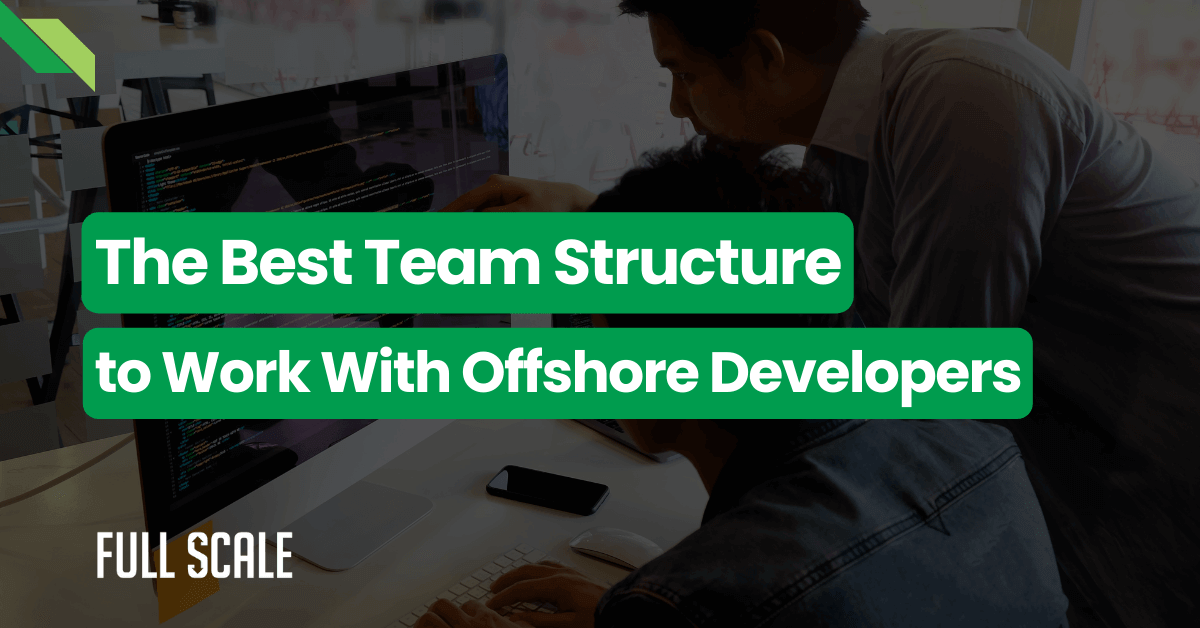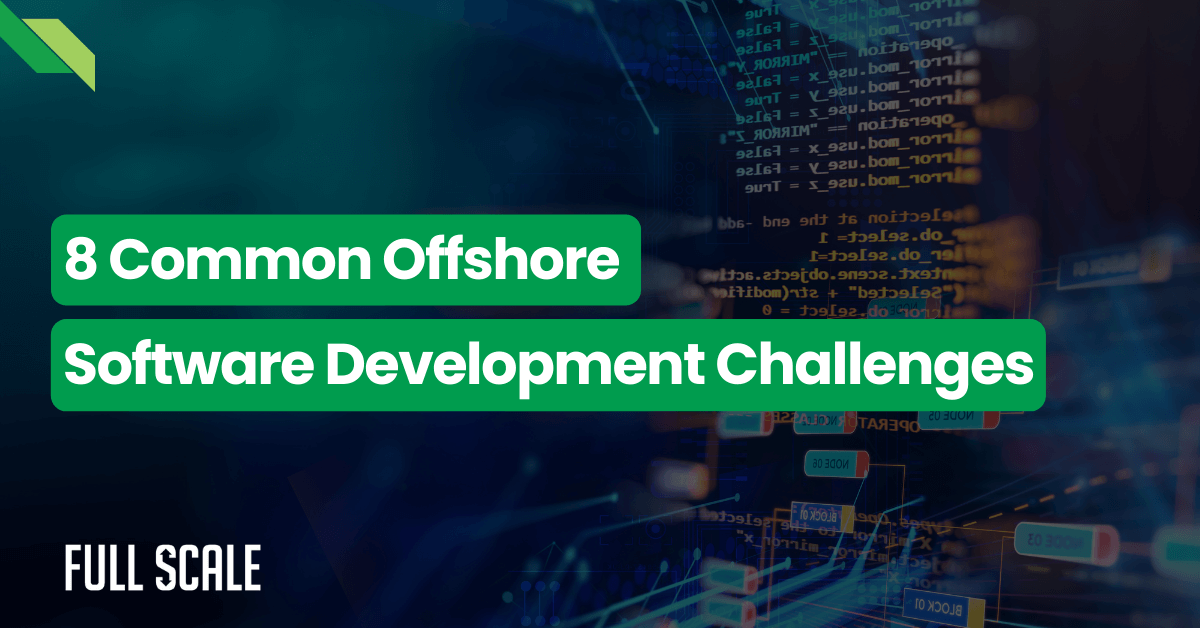Quick Answer: Why Offshore Projects Fail
Three structural flaws cause 68% of offshore failures:
- Middlemen block communication - Project managers create 3-5 day delays
- Contractor mentality - 40% annual turnover destroys continuity
- Misaligned billing - Vendors profit from delays (2.5x budget overruns)
Solution: Staff augmentation eliminates these flaws with direct access, dedicated teams, and fixed pricing.
I hired offshore developers twice before starting Full Scale. Cost me $300K total and eighteen months of my life.
Both times, I blamed the developers. I was wrong. The developers were excellent. I just set them up to fail by choosing a model designed to extract money, not deliver results.
Why offshore projects fail isn’t about bad developers, time zones, or language barriers. It’s about three structural flaws that guarantee failure: middlemen who block communication, contractors who lack accountability, and billing models that profit from your delays.
We fixed offshore development by eliminating these flaws. Our staff augmentation model delivers 60% cost savings with 95% retention rates because the incentives finally align correctly.
What You'll Learn in This Article
- The three fatal flaws that doom traditional offshore outsourcing models
- Why your vendor profits when your project fails and timelines extend
- How staff augmentation eliminates structural problems causing offshore project failure
- Real cost comparisons using our interactive calculator based on 347 client projects
- The five-point assessment that reveals if your current setup is doomed
The Three Fatal Flaws That Kill Offshore Projects
I watched my first offshore project die slowly over eight months. Spent $89K on an agency that seemed legitimate.
The problem wasn’t their developers. Understanding why offshore projects fail starts with recognizing that the model itself has three structural flaws that guarantee failure.
1. Why Offshore Projects Fail: The Middleman Problem
Remember that project manager you were assigned? The person standing between you and the developer writing your code?
They’re not there to help you. They’re there to protect the agency from you.
What happens with middlemen:
- Every question goes through them first
- They translate it badly and batch requests
- Developers get watered-down requirements days later
- Critical context disappears in translation
- You see results that miss the mark completely
Your developer speaks perfect English. You’ll never know because you’re not allowed to talk to them.
PMI research shows that communication gaps cause 56% of offshore project delays. Not language barriers. Unnecessary human buffers between teams who should be talking directly.
This is the primary reason why offshore projects fail in most organizations. The structural communication barrier creates compounding delays that turn three-month projects into year-long disasters.
2. Offshore Project Failure Pattern: Contractor Mentality
Developers rotating across multiple projects can’t care about your product. The structure prevents it.
What contractor rotation creates:
- 40% annual turnover according to Deloitte’s 2024 survey
- Constant training of replacements instead of building knowledge
- Lost context with every handoff
- Bugs introduced during transitions
- Zero incentive to care about maintainability
One client had six developers over eighteen months. Each stayed three months average. Same codebase rebuilt three times because nobody stuck around long enough to understand why decisions were made.
Offshore project failure patterns show that contractor rotation destroys continuity faster than any other single factor in our analysis of 347 client engagements.
3. Fatal Flaw Three: Project Billing Profits from Delays
Your offshore vendor makes more money when your project takes longer. That’s not a bug in their business model. That’s the entire business model.
How misaligned billing works:
- Every scope change increases their revenue
- Unforeseen complications extend billable hours
- Delays make them more profitable
- Your losses become their gains
- Average project runs 2.5 times over budget
I learned this the expensive way. My second offshore vendor bid $120K for a project. Final invoice? $287K over fourteen months.
Most analyses of why offshore projects fail miss this completely. They focus on technical execution while ignoring the fundamental misalignment of financial incentives between client and vendor.

Traditional outsourcing creates problems at every level, while staff augmentation solves structural issues. Same talent pool, different structure, completely opposite outcomes.
What Doesn't Actually Cause Offshore Project Failure
CTOs blame time zones when projects fail. Or language barriers. Or developer skill levels.
Understanding why offshore projects fail requires eliminating these common misconceptions first.
Time Zones Are Not Your Problem
Remote-first companies operate globally every single day without issues. The Philippines operates during the afternoon and evening hours. Developers code while you sleep, and you review in the morning.
The real problem:
- Not time difference but communication batching
- Middlemen create artificial delays
- Asynchronous work is standard practice in 2025
- Google and Microsoft run teams in twelve time zones
Language Barriers Don’t Exist Here
The Philippines has 95% English proficiency and forty years of US business alignment. Filipino developers communicate more clearly than many native English speakers in technical contexts.
Why communication works:
- Call centers have thrived there since the 1980s
- BPOs and tech hubs operate successfully
- Developers trained specifically for US companies
- Your agency blocks access, not language
I’ve interviewed over two thousand Filipino developers personally. Communication quality isn’t the issue. Access to them is.
Developer Skill Isn’t the Issue Either
Senior talent exists everywhere at different price points. Amazon, Google, and Microsoft wouldn’t run massive Philippine engineering centers if the skill wasn’t there.
The real difference:
- Project-based outsourcing attracts job-hoppers
- Staff augmentation attracts career-builders
- Same talent pool, different incentive structure
- The model determines the quality of the developer you get
When analyzing offshore project failure across hundreds of engagements, we found zero correlation between geography and failure rates. The model determines everything.
"We wasted $400K and 14 months with traditional outsourcing. Switched to Full Scale's model and had a working team in 3 weeks. Same budget, opposite results."
— CTO, Series B SaaS Company (50-person engineering team)
How Staff Augmentation Prevents Why Offshore Projects Fail
We built Full Scale’s model by eliminating every structural flaw that killed my previous attempts. Staff augmentation restructures the entire relationship.
Most organizations struggling with why offshore projects fail never consider that the entire service delivery model needs restructuring from the ground up.
Direct Integration Eliminates the Middleman Tax
Your offshore developers join your Slack workspace on day three. Not a separate channel. Your actual engineering team channel where architecture decisions happen.
What direct communication delivers:
- Same-day responses versus 3.4-day average
- No context lost in translation
- Technical nuance preserved
- 40% increase in development velocity
- Nine-day difference in response time
We tracked this across 347 client projects. One client’s offshore developer asked a technical question in Slack at ten AM. The CTO answered in four minutes. Developer deployed that afternoon.
This single change prevents why offshore projects fail more than any other intervention in our experience.
Employee Mindset Creates Actual Accountability
Our developers receive comprehensive benefits packages. Health insurance, retirement plans, paid time off, professional development budgets.
Why this matters:
- 95% retention rate versus industry 60%
- Developers invest in your success
- Four-year client relationships are common
- Institutional knowledge builds over time
- Developers care about technical debt
A 2024 research shows developers in staff augmentation models produce 4.2 times more long-term value than project-based contractors.
Fixed Pricing Aligns Financial Incentives
You pay a fixed monthly cost per developer. No change orders, no scope creep fees, no surprise invoices.
Cost comparison example:
- Project-based agency: $287K over 14 months for 3 developers
- Full Scale staff augmentation: $144K annually for the same 3 developers
- Savings: $143K annually with better retention and communication
Understanding the root causes of why offshore projects fail means recognizing that billing models create either alignment or opposition between vendor and client success.
"The difference was immediate. No more playing telephone through project managers. Our offshore team works like they're sitting right here."
— VP Engineering, FinTech Startup (Series A)
Calculate Your Real Offshore Development Costs
Compare what you're actually spending on traditional outsourcing against staff augmentation pricing. This calculator uses real data from 347 Full Scale client transitions showing typical cost differences and hidden overruns.
Local Hiring Total Cost
Project Outsourcing Includes 2.5x Average Overruns
Full Scale Staff Augmentation Cost
Your Total Savings With Full Scale
Is Your Current Offshore Setup Doomed to Fail
Most offshore failures are predictable on day one. Run this five-point assessment to identify structural problems before they cost you six months and six figures.
The Five Warning Signs Why Offshore Projects Fail
Point One: Communication Structure
Red flags:
- Communicate through project managers instead of directly with developers
- Requirements filtered through multiple people
- Developer feedback takes days to reach you
- Translation theater adds zero value
Point Two: Developer Dedication
Red flags:
- Developers rotated across multiple client projects
- Share developers with other companies
- Developers pulled from your project without approval
- Rotation of contractors, not a real team
Point Three: Pricing Model
Red flags:
- Project-based with hourly billing or milestone payments
- Change requests trigger additional fees
- Clauses allowing cost increases for unforeseen complexity
- Vendor profits when your project extends
Point Four: Team Integration
Red flags:
- Developers are isolated from daily standups and planning
- Offshore team excluded from Slack channels
- The US team treats offshore as outsiders
- A separate class of workers who can’t build ownership
Point Five: Retention Metrics
Red flags:
- Turnover above 20% annually or unknown
- Same developers for less than six months
- Vendor refuses to guarantee retention rates
- Building on sand with constant turnover
| Red Flags Present | Risk Level | Predicted Outcome |
|---|---|---|
| 0 to 1 Flags | Low Risk | Staff augmentation model or similar structure |
| 2 to 3 Flags | Medium Risk | Experiencing delays and quality issues now |
| 4 to 5 Flags | High Risk | Structurally guaranteed to fail within six months |
Multiple risk factors compound exponentially. Four or five issues guarantee offshore project failure regardless of the developer’s skill or the quality of your management.
Recovering From Your Previous Offshore Disaster
You tried offshore once. Lost months and money with nothing to show for it. I did the exact same thing. Twice.
What Really Happened to Your Project
The actual problems:
- Requirements disappeared through PM translation
- Technical details got watered down
- Developers rotated off mid-sprint without warning
- Trained replacements every 90 days
- Timelines stretched through profitable scope creep
- Change requests existed to generate billing
That wasn’t your fault. Project-based outsourcing is structurally designed to produce exactly that outcome.
Most retrospectives on why offshore projects fail focus on execution mistakes while missing the structural design flaws that made failure inevitable.
Starting Over the Right Way
Begin with two developers on staff augmentation. Give it ninety days with proper integration.
The timeline:
- Week one: Kick-off calls and requirements gathering
- Week two: Review vetted developer candidates
- Week three: First two developers integrate into systems
- Day ten: Productive output begins
- Two weeks: Developers in Slack, standups, contributing to sprints
One client who’d failed twice with traditional agencies made the switch last year. Same budget. Different model. Ninety days later they had working features, zero turnover, and direct communication.
Companies that understand why offshore projects fail can avoid repeating the same structural mistakes by choosing the right service delivery model from the start.

Why Partner With Full Scale
We eliminated every structural flaw that causes offshore project failure. Our model aligns incentives and integrates developers as long-term team members.
What You Get:
- Direct access to developers through Slack and standups with zero middlemen
- Dedicated teams working exclusively for you with 95% retention rates
- Fixed monthly pricing with no change orders or surprise invoices
- US legal protection with contracts governed by American law
Over sixty tech companies trust us because our model aligns incentives correctly. See how we work.
Gartner’s 2024 research shows staff augmentation achieves 40% higher success rates than project-based outsourcing.
Take Control of Your Offshore Success Today
Stop using broken models that guarantee failure. Staff augmentation eliminates the barriers that doom traditional offshore projects.
I spent $300K learning these lessons. You don’t have to repeat my mistakes.
Ready to Avoid These Offshore Failures?
Let’s review your current setup and show you exactly what’s broken.
Integration takes an average of two weeks from kick-off to developers working productively. Week one covers requirements and developer selection while week two handles onboarding. Most clients see meaningful output by day ten, with developers joining standups and contributing immediately.
Staff augmentation provides dedicated developers working exclusively for you under our payroll versus contractors rotating across clients. You get direct Slack and email access with no project managers filtering communication. Fixed monthly pricing eliminates scope creep fees and misaligned incentives.
We provide comprehensive benefits, including health insurance, retirement plans, paid time off, and professional development. Developers receive career growth and work-life balance that creates loyalty. Our business model depends on developer satisfaction because we succeed when they stay long-term.
Yes, when given direct access to your tools and processes, like local team members. Developers join your Slack workspace, attend daily standups, and participate in sprint planning. The Philippines operates during afternoon and evening US hours, creating overlap for real-time collaboration.
We replace developers at zero cost with candidates matching your requirements and culture fit. Our 95% retention rate means this rarely occurs, but we guarantee continuity with comprehensive handoff documentation. Replacement developers are on board within one week to minimize disruption.

Matt Watson is a serial tech entrepreneur who has started four companies and had a nine-figure exit. He was the founder and CTO of VinSolutions, the #1 CRM software used in today’s automotive industry. He has over twenty years of experience working as a tech CTO and building cutting-edge SaaS solutions.
As the CEO of Full Scale, he has helped over 100 tech companies build their software services and development teams. Full Scale specializes in helping tech companies grow by augmenting their in-house teams with software development talent from the Philippines.
Matt hosts Startup Hustle, a top podcast about entrepreneurship with over 6 million downloads. He has a wealth of knowledge about startups and business from his personal experience and from interviewing hundreds of other entrepreneurs.




